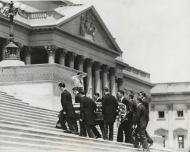Funerals in the House Chamber
Historical Highlight
Historical Highlight
Historical Highlight
 /tiles/non-collection/i/im_inst_funerals_PA2011_09_0040b.xml
Collection of the U.S. House of Representatives
/tiles/non-collection/i/im_inst_funerals_PA2011_09_0040b.xml
Collection of the U.S. House of RepresentativesAbout this object Speaker Joseph Byrns' coffin was borne into the Capitol for funeral services attended by Members of Congress, President Franklin D. Roosevelt and his cabinet, the diplomatic corps, and the Supreme Court.
The United States Capitol Rotunda is known widely as a space where the nation pays tribute to its most revered citizens, whose bodies lie in state or in honor in that room. Comparatively little is known about funerals that took place in the Hall of the House. Beginning with Congressman Nathaniel Hazard of Rhode Island in 1820, the House Chamber has hosted 32 funerals for sitting Members. As time progressed, the House developed standing practices that were employed when a serving Member passed away: the announcement of the Member’s death was made on the House Floor; a resolution was made regarding the funeral; a resolution was made to don black armbands for a period of 30 days; Congress adjourned out of respect; and the House followed by hosting or attending the funeral.
From the early 1800s to 1870s, many Members of the House that died in the capital city were buried in Congressional Cemetery, located in the northeast section of Washington, D.C. Of the 71 Members buried at Congressional Cemetery (six were later moved), eight had funerals in the House Chamber. In addition, 109 Members of the House are honored in Congressional Cemetery with cenotaphs—four-sided memorial stones with a name engraved on each side of the monument. Eight of the cenotaphs, including that of John Quincy Adams of Massachusetts, memorialize those Members whose funerals were held in the House Chamber. The practice of the cenotaphs ended in the 1870s with the exception of two: Representatives Hale Boggs of Louisiana and Nicholas Begich of Alaska, who passed away in 1972. In cases where the late Representatives’ funerals were not held in the Capitol, Members were transported by funeral train back to their home district or a location designated by the family. A delegation from the House was traditionally appointed to attend the funeral. The House paid for the cost of the delegation’s travel and documented the outlay in the Clerk’s contingent expenses report.
On occasion, what was referred to as a “state funeral” was held in the House Chamber. These state funerals generally had a specific guest list consisting of the President, Justices of the Supreme Court, Senators, and fellow House Members. Both Speaker Champ Clark of Missouri and Representative James Mann of Illinois (see photo to the right) were accorded state funerals in the chamber.
With Congress and the country continuing to grow, the House agreed to set a $1,000 spending limit out of its contingent expenses to cover the cost of funerals in 1883. This was designed to put a stop to extravagant funerals, which were becoming more prevalent.
In 1932, during the depths of the Great Depression, the House determined that sitting Member funerals no longer would be paid for with contingent expenses of the House. The last funeral to take place in the House Chamber was Speaker William Bankhead of Alabama in 1940. When retired, Speaker Thomas “Tip” O’Neill of Massachusetts passed away in 1994, Congress honored the former Speaker by adorning the rostrum on the House Floor with funeral wreaths.
| Member | Date of Funeral Service | Location |
|---|---|---|
| Nathaniel Hazard* | December 18, 1820 | House Chamber |
| Jesse Slocumb* | December 21, 1820 | House Chamber |
| John Linn** | January 6, 1821 | House Chamber |
| William A. Burwell* | February 17, 1821 | House Chamber |
| Thomas T. Bouldin* | February 13, 1834 | House Chamber |
| Warren R. Davis* | January 30, 1835 | House Chamber |
| Jonathan Cilley** | February 27, 1838 | House Chamber |
| Joab Lawler* | May 9, 1838 | House Chamber |
| Lewis Williams** | February 25, 1842 | House Chamber |
| Joseph Lawrence* | April 19, 1842 | House Chamber |
| Pierre E. Bossier** | April 26, 1844 | House Chamber |
| William Taylor* | January 19, 1846 | House Chamber |
| Richard P. Herrick** | June 23, 1846 | House Chamber |
| John Quincy Adams** | February 26, 1848 | House Chamber |
| James A. Black** | April 5, 1848 | House Chamber |
| Preston Brooks | January 29, 1857 | House Chamber |
| Philip Johnson** | February 3, 1867 | House Chamber |
| David B. Mellish | May 26, 1874 | House Chamber |
| Samuel Hooper | February 16, 1875 | House Chamber |
| Julian Hartridge | January 9, 1879 | House Chamber |
| Edmund W.M. Mackey | January 30, 1884 | House Chamber |
| Morrison R. Waite1 | March 28, 1888 | House Chamber |
| William D. Kelley | January 11, 1890 | House Chamber |
| Nelson Dingley, Jr. | January 16, 1899 | House Chamber |
| Amos Cummings | May 4, 1902 | House Chamber |
| Sereno E. Payne | December 13, 1914 | House Chamber |
| James B. (Champ) Clark | March 5, 1921 | House Chamber |
| James R. Mann | December 3, 1922 | House Chamber |
| Martin B. Madden | April 29, 1928 | House Chamber |
| Edward W. Pou | April 2, 1934 | House Chamber |
| Joseph W. Byrns | June 5, 1936 | House Chamber |
| William B. Bankhead | September 17, 1940 | House Chamber |
*indicates the Member is buried in Congressional Cemetery.
**indicates the Member is memorialized on a cenotaph at Congressional Cemetery.
Footnotes
1Morrison R. Waite served as Chief Justice of the Supreme Court and died on March 23, 1888.





